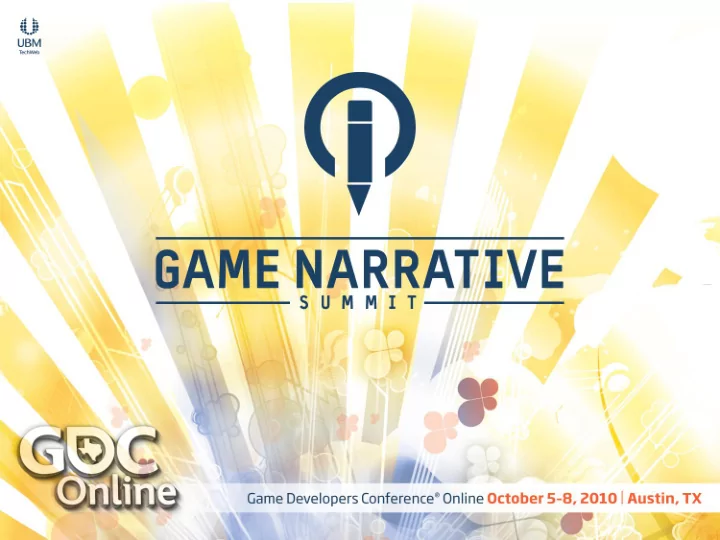

Puzzle Writing: Best Practices Clara Fernandez-Vara Singapore-MIT GAMBIT Game Lab 2 2
Who am I?
The Hobbit Zork: The Great Underground Adventure (1983) (1982) Space Quest IV: Roger Wilco and the Myst Time Rippers (1993) (1993)
Summary What is a puzzle? Puzzle patterns Evaluating your puzzle
What is a puzzle? It’s a problem in need of one solution ... but ideally more than one path to that solution. Not a competitive challenge. Requires more thinking than skills.
What is a puzzle? It’s a mystery that we feel compelled to solve. It’s a gap that the player has to fill. See Danesi, Marcel. The Puzzle Instinct. Bloomington, IN: Indiana University Press, 2002.
What is a puzzle? In order to solve the puzzle, the player needs to achieve insight. Insight provides pleasure: feeling clever is fun. Insight can be incremental.
Integrating Puzzles and Story A single solution helps bringing the player to a specific situation once the puzzle is solved. Characters and props in the puzzle should also be part of the story.
The Contract Between Designer and Player Games where puzzle and story and game are integrated have an implicit contract. If the player is too difficult, or too easy so there is no challenge, the player will lose interest. If the player gives up, she will not experience the story. The puzzle has to be fair to the player. Player must have all the information needed to solve the puzzle. In videogames, designers should not be trying to prove their cleverness, but helping the player feel clever.
Puzzle Patterns Different ways to achieve insight Selective Encoding Selective Comparison Selective Combination From Sternberg, Robert. Beyond IQ: A Triarchic Theory of Human Intelligence. Cambridge: Cambridge University Press, 1985.
Selective Encoding Making apparently irrelevant information relevant.
Selective Comparison Using analogies and metaphors, in order to draw a non-obvious relationship between two pieces of information.
Selective Combination Joining pieces of information in order to form a novel one.
Evaluating Your Puzzles Writers/designers can evaluate their puzzles even before they are implemented. What follows is a checklist, in the form of questions, to ask oneself before implementing the game. This list is not a substitute for playtesting.
Evaluating Your Puzzles: The Basics What knowledge does the player need to solve the puzzle? Knowledge of the world Socio-cultural activities Math Physics Logic If the knowledge does not come from everyday life, is it provided in the game? How is the information given?
Evaluating Your Puzzles: Integrating Puzzles and Story Does the puzzle include characters and objects from the story? Does the solution to the puzzle constitute an event in the story?
Evaluating Your Puzzles: Difficulty If knowledge of the world is needed to solve the puzzle, how specific is it? If the knowledge is given in the game: How far apart is the information provided? How accessible is the information? Is the information redundant? Can it be re-accessed?
Evaluating Your Puzzles: Localization Is the puzzle based on puns or specific cultural knowledge?
Evaluating Your Puzzles: Usability How obvious is it that there is a puzzle? How obvious are the pieces of information? See Randy Smith’s talk at GDC 2009: Helping Your Players Feel Smart: Puzzles as User Interface
Conclusion Puzzles are one of the devices that bring together writing and game design. Designers / writers should respect the contract with the player to provide a fair puzzle. Most puzzles can be solved by following three basic types of thinking. Many of these principles also apply to math / physics/ logic puzzles.
Thank you for listening! Questions? telmah@mit.edu Twitter: clarafv http://gambit.mit.edu 34 34
Note This presentation is directed to writers / designers. It focuses on integrating puzzles in the story. Puzzles are highly dependent on environmental narrative, so they involve all disciplines.
Selective Encoding Making apparently irrelevant information relevant.
38
Recommend
More recommend